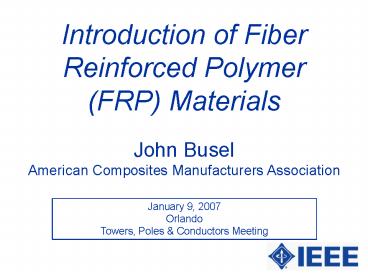Introduction of Fiber Reinforced Polymer FRP Materials - PowerPoint PPT Presentation
1 / 28
Title:
Introduction of Fiber Reinforced Polymer FRP Materials
Description:
Introduction of Fiber Reinforced Polymer (FRP) Materials. John Busel. American Composites Manufacturers ... Impervious to pests and woodpecker attack ... – PowerPoint PPT presentation
Number of Views:11786
Avg rating:5.0/5.0
Title: Introduction of Fiber Reinforced Polymer FRP Materials
1
Introduction of Fiber Reinforced Polymer (FRP)
Materials
John Busel American Composites Manufacturers
Association
January 9, 2007 Orlando Towers, Poles
Conductors Meeting
2
Outline
- What is FRP ?
- FRP benefits
- Current Status of FRP Utility Structures
- Installations
- FRP performance
- Changes to 2007 NESC code
3
What is FRP ?
Compared to other engineering materials
composites have different properties
4
What is FRP ?The Difference Between Composites
and Other Materials
5
What is FRP ? Fiber Reinforced Polymer (FRP)
Composites
Definition Composites are a combination of a
reinforcement fiber in a polymer resin matrix,
where the reinforcement has an aspect ratio that
enables the transfer of loads between fibers, and
the fibers are chemically bonded to the resin
matrix.
Creates a material with attributes superior to
either component alone!
6
What is FRP ?
- Products made for utility structures are
manufactured several ways - Pultrusion
- Filament Winding
7
What is FRP ?
Pultrusion Process
Bridge decks, rebar, structural profiles,
concrete masonry structural strengthening,
sheet piling, dowel bars, utility poles, grating
8
What is FRP ?
Filament Winding
Utility poles, columns, bridge girders, pipe,
missiles, aircraft fuselage
9
FRP Benefits
- Lightweight easy to handle and transport
- High Strength to weight ratio
- Corrosion resistant will not rot or corrode
- Non-conductive (essentially a large hot stick)
- Non-magnetic
- Impervious to pests and woodpecker attack
- Design Tailor material properties, some systems
are modular - Compatible use standard hardware
- Environmentally safe no leaching of toxic
chemicals into soil
10
Current Status of FRP Utility Structures
- FRP utility structures include poles, crossarms,
stand-offs and now conductor reinforcement - Composite, or fiberglass poles, were installed
in West Oahu in 1962 and were only recently taken
out of service - Composite lighting poles have an extensive
history of use dating back more than 40 years - The use of FRP utility structures throughout the
U.S. is widespread and still growing - The use of FRP utility structures in Canada is
growing - Some larger installations...
- 8,000 FRP poles at large California utilities
starting 1995 - 1,500 FRP poles at Rural Coops since 2000
- 300 FRP poles at Northwest Territories since
2003 - 100,000 FRP crossarms across virtually every
state
11
Installations
12
Residential Backyard Installations
13
Remote Installations
14
Deadend Crossarms
15
Joint Use with Transformers
16
FRP Performance
Claim by ManufacturersSince FRP structures are
engineered like steel and prestressed concrete,
and manufactured, they result in good initial
strength consistency Question Is this true?
17
FRP Performance
Answer Yes EDM has performed
numerous proprietary bending strength tests on
FRP utility poles and crossarms for several
manufacturers. Conclusion the poles and
crossarms yielded very consistent (low COV) as
manufactured strength properties
18
FRP Performance
Actual 40' Filament Wound Pole Bending Strengths
(Tested by EDM)
COV 6.1
19
FRP Performance
Actual 40' Pultruded Pole Bending
Strengths (Tested by Manufacturer)
COV 3.4
Load-Deflection very nearly linear
20
FRP Performance
- The first FRP poles for overhead line application
were designed using a net overload factor
(Application Safety Factor) of 4.0, the same as
required for (Grade B) wood construction - Question What factors are now being employed for
FRP Utility Poles and Crossarms?
21
FRP Performance
- The use of overload factors as applied to FRP
utility poles is all over the map - Some utilities using a factor of 2.5
- Some using 3.0
- Some using 3.85
- Some still using 4.0
22
FRP Performance
- The use of overload factors as applied to FRP
crossarms is more consistent - Most utilities use a factor of 2.5
23
FRP Performance Failure Mechanisms of FRP Poles
- Cantilever Loading
- Load-deflection curve very nearly linear
- Typical break is due to local stress rupture on
the compression face and is most often associated
with local buckling - Kinematics of pole deflection cause loss of
cross-section inertia as the pole begins to oval
which means EI decreases - Failure in area where applied stress first
exceeds allowable stress - Typical allowable stresses in the range of 25,000
psi to 45,000 psi
24
FRP Performance Failure Mechanisms of FRP
Crossarms
- Tangent and Deadend Loading
- Load-deflection curve very nearly linear
- Typical break is due to local stress rupture on
the compression face and typically propagates
from the attachment to the pole - Crossarm breaks can also be snap breaks, or
crushing breaks if crossarm mounted directly to
pole without a bracket - Failure in area where applied stress first
exceeds allowable stress - Typical allowable stresses in the range of 25,000
psi to 45,000 psi. - FRP crossarms are typically pultruded and perform
like pultruded poles
25
Changes to 2007 NESC
- Subcommittee 5 Strength Loading
- Sections 24, 25, 26, 27
- Taskforce 5.1.7 FRP Structures
- Change Proposal accepted in 2005
- Reduced Application Safety Factor
- Material Strength Factors same as STEEL provided
that FRP pole and crossarm strengths are
published as 5 LEL values (5th percentile
strength)
26
Changes to 2007 NESC
- Added NOTE References
- ASCE-104, Recommended Practice For
Fiber-Reinforced Polymer Products For Overhead
Utility Line Structures - ASCE-111, Reliability-Based Design of Utility
Pole Structures .. (provides 5 LEL) - ASCE/SEI Task Committee develop FRP Manual of
Practice
27
Changes to 2007 NESC
28
Table 261-1AStrength Factors for Structures
Changes to 2007 NESC































